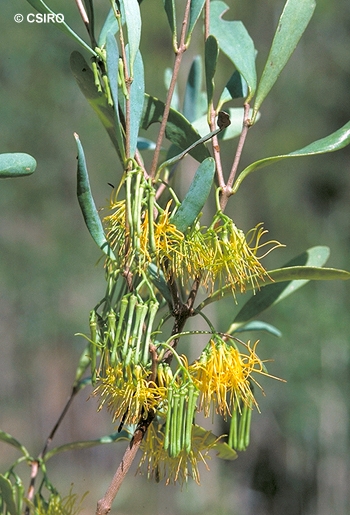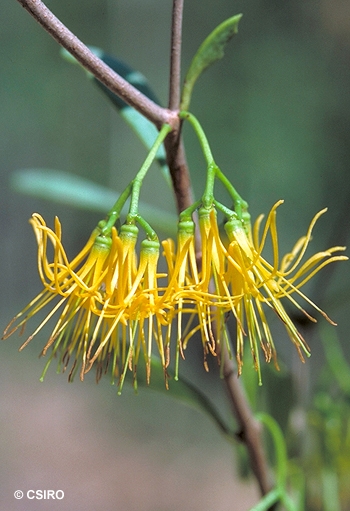Australian Tropical Rainforest Plants - Online edition
Amyema congener (Sieber ex Schult. & Schult.f.) Tiegh. subsp. congener
Barlow, B.A. (1966) Australian Journal of Botany 14(3): 462.
Aerial stem-parasitic shrub. Epicortical runners absent.
Leaf blades thick and leathery, breaking along a straight line when bent back on themselves, venation not at all obvious. Leaf blades about 3-6.5 x 0.7-2 cm, petioles about 0.2-0.4 cm long.
Flowers borne in triads, the central flower sessile, the lateral flowers pedicellate (2-3 mm) triads borne in 3-5-rayed umbels, rays about 5-8 mm long. Primary peduncles about 10-35 mm long. Calyx about 1 mm long, devoid of lobes. Corolla about 16-35 mm long, green at first but turning yellow. Anthers about 2-3 mm long, staminal filaments about 8 mm long. Disk undulate, surrounding the base of the style. Style + stigma about 20-23 mm long, stigma small, globose.
Fruits about 10 x 7 mm, sparsely clothed in short hairs, calyx persistent at the apex. Seed about 3-7 mm long with an embryo protruding from one end. Seeds marked with 4 longitudinal white lines, immersed in a white or translucent sticky mucilage. Embryo green, about 5 mm long, embedded in sticky endosperm. Cotyledons fused at the apex. Endosperm green.
Features not available.
Endemic to Australia. Occurs in CYP, NEQ, CEQ and southwards as far as southern coastal NSW. Mostly in open eucalypt forest but sometimes found in rain forest and monsoon forest. Altitudinal range in NEQ from 200-800 m. Frequently parasitic on Casuarinaceae and Acacia.
Food plant for the larval stage of the Imperial Jezabel, Black Jezabel, Dark Purple Azure, Satin Azure, Southern Purple Azure and Trident Pencilled-blue Butterflies. Braby, M. (2000).








